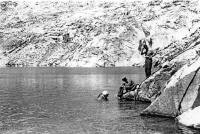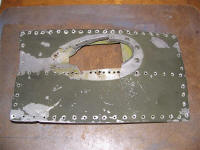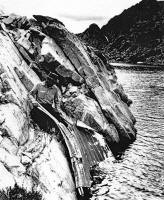|
Aircraft Wrecks in the
Mountains and Deserts of the American West
B-24E
12/5/43
On December 5, 1943 a
routine night training mission went bad when a Consolidated B-24E was posted
missing over the Sierra Nevada Mountains of California. Extensive search
missions were flown without result. Clint Hester the father of 41-28463's
co-pilot 2nd Lt. Robert M. Hester made summer trips into the High Sierra
spanning seventeen years searching for his son's plane. Two geologists
discovered the crash site on July 29, 1960 more than one year after the death of
Clint Hester. Two military sponsored expeditions were made to Hester Lake in
1960-61 to recover the remains of the crew. Only partial success was achieved.
Freezing water temperatures, high altitude environment, and a deep lake made
SCUBA diving very dangerous. The remains that were recovered are buried at
Arlington National Cemetery in one grave except for S/Sgt Robert O. Bursey who
is buried in Rutland, Vermont.
Over the years several
expeditions have been mounted to reach Hester Lake with dive equipment in order
to better survey the remains of Consolidated B-24E 41-28463 and its crew. Only a
few have been successful in reaching the 11,266' lake far from any trails and
protected by the daunting terrain of the Sierra Nevada Mountains. The only
approach to Hester Lake is up a steep and dangerous boulder strewn gully above
LeConte
Canyon. Hester Lake is up to 110' in depth and about 600yds in length. Its
frigid waters still preserve the plane and the remains of the crew.
The crewmen of B-24E
41-28463 are: Pilot, 2nd Lt. Charles W. Turvey; co-pilot, 2nd Lt. Robert M.
Hester; navigator, 2nd Lt. William T. Cronin; bombardier, 2n Lt. Ellis H. Fish;
flight engineer, S/Sgt Robert O. Bursey; and radio operator, Sgt. Howard A.
Wandtke.
Hester
Lake
derives its name today to honor Clint Hester who would not give up the search
for his son and crew aboard 41-28463.

Once an unnamed lake in
the High Sierra, now known as Hester Lake, as seen by military recovery team
in August 1960. Photo via MSgt. Robert Koch USAF retired. This view is
looking toward the ridge impact point of B-24E #41-28463. 95% of the ill
fated B-24 came to rest in the lake. |

Starboard (right side)
nose panel where pitot tube arm was attached. Interior view of panel with
notes made by USAF MSgt Robert Koch. Part recovered from crash site August
1960. Artifact courtesy of MSgt Robert Koch USAF retired.
|

U.S. Navy hard hat salvage diver works
in Hester Lake with the assistance of USAF personnel during the late summer
of 1960. (photo courtesy Sequoia/Kings Canyon National Park Archive) |

Exterior view of nose
panel of #41-28463 with part of pitot tube whisker fairing still intact.
Standard O.D. paint still visible on the panel. All rivets were drilled out
at time of recovery. Artifact courtesy of Robert Koch USAF retired.
|

Park Service employee and section of
B-24E aluminum skin recovered from Hester Lake in 1960. A USAF Piasecki/Vertol
H-21B Workhorse helicopter was used to fly in the salvage crew, and recover
the partial remains of the crew and their plane. (photo courtesy
Sequoia/Kings Canyon National Park) |
|
|